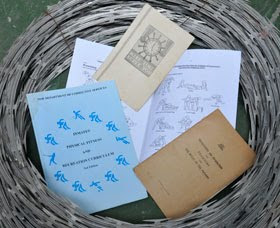While taking part in Oral Histories research conducted by Maitland Gaol staff, a former Senior Overseer in charge of the gaol’s saddlery for more than 20 years, has refuted claims that infamous con-man and escapee Darcy Dugan was a central figure in the 1975 riot that saw inmates cause extensive damage before being tear-gassed and the ring-leaders shanghaied.
Dugan was, at the time working in the saddlery, manufacturing an assortment of horse blankets, medicine balls, soft ball bases and hospital / ambulance stretchers. On the morning of the riot, Darcy presented the OIC with a “sick pass” and was allowed to return to his cell in B Wing for the remainder of the day. The riot began, in Darcy’s absence, around midday. The Overseer believes that “Darcy knew something was going on, but wanted no part of it”. He also recalls that Dugan, who later in life gained some renown as a landscape painter “wasn’t much good really, till Ricky Robinson gave him a few tips”.
Ricky was an Aboriginal inmate transferred to Maitland from Grafton. Noting Ricky’s artistic talent, the Overseer commissioned him to adorn the saddlery walls in exchange for tobacco rations. Other inmate artists, including a professional art forger were also assigned to the task. Of the 5 artworks completed, 3 bare the signature of Ricky Robinson. The largest, a mural covering the southern wall of the building, features a horseman chasing brumbies over an expansive outback landscape. The water-damaged and restored mural, was, according to the Overseer, painted over another mural depicting an early settlers’ homestead scene, which for some unknown reason didn’t meet with Ricky’s expectations.
It is planned that in the not-too-distant future, visitors to Maitland Gaol will be able to view the growing collection of inmate artworks, including those by Robinson and Dugan, held on site. Anyone with prison-made artworks who would be interested in loaning them to the gaol for a proposed future exhibition are encouraged to contact Maitland Gaol on (02) 4936 6482 or email info@maitlandgaol.com.au


















